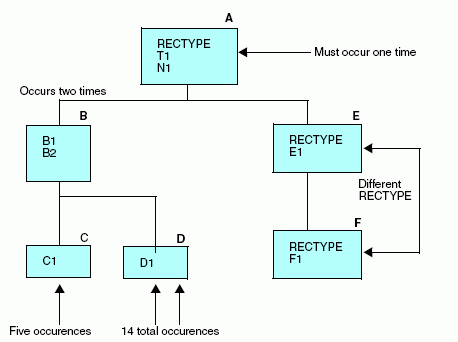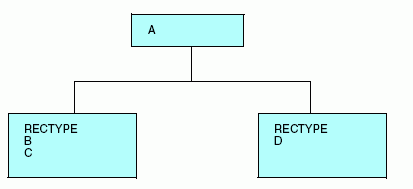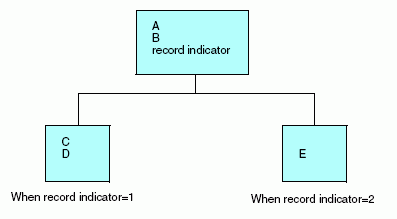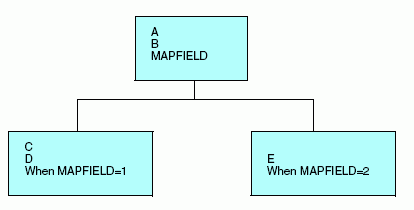Combining Multiply Occurring Fields and Multiple Record Types
You can have two types of descendant
segments in a single fixed-format sequential, VSAM, or ISAM data
source:
- Descendant segments consisting of multiply
occurring fields.
- Additional descendant
segments consisting of multiple record types.
xDescribing a Multiply Occurring Field and Multiple Record Types
In the data structure shown below, the first record
(of type 01) contains several different sequences of repeating fields,
all of which must be described as descendant segments with an OCCURS
attribute. The data source also contains two separate records, of
types 02 and 03, which contain information that is related to that
in record type 01.
The relationship between the records
of various types is expressed as parent-child relationships. The
children that contain record types 02 and 03 do not have an OCCURS attribute.
They are distinguished from their parent by the field declaration
where field=RECTYPE.

The description for this data source
is:
FILENAME = EXAMPLE1, SUFFIX = FIX,$
SEGNAME = A, SEGTYPE=S0,$
FIELDNAME = RECTYPE ,ALIAS = 01 ,USAGE = A2 ,ACTUAL = A2 ,$
FIELDNAME = T1 ,ALIAS = ,USAGE = A2 ,ACTUAL = A1 ,$
FIELDNAME = N1 ,ALIAS = ,USAGE = A1 ,ACTUAL = A1 ,$
SEGNAME = B, PARENT = A, OCCURS = VARIABLE, SEGTYPE=S0,$
FIELDNAME = B1 ,ALIAS = ,USAGE = I2 ,ACTUAL = I2 ,$
FIELDNAME = B2 ,ALIAS = ,USAGE = I2 ,ACTUAL = I2 ,$
SEGNAME = C, PARENT = B, OCCURS = B1, SEGTYPE=S0,$
FIELDNAME = C1 ,ALIAS = ,USAGE = A1 ,ACTUAL = A1 ,$
SEGNAME = D, PARENT = B, OCCURS = 7, SEGTYPE=S0,$
FIELDNAME = D1 ,ALIAS = ,USAGE = A1 ,ACTUAL = A1 ,$
SEGNAME = E, PARENT = A, SEGTYPE=S0,$
FIELDNAME = RECTYPE ,ALIAS = 02 ,USAGE = A2 ,ACTUAL = A2 ,$
FIELDNAME = E1 ,ALIAS = ,USAGE = A1 ,ACTUAL = A1 ,$
SEGNAME = F, PARENT = E, SEGTYPE=S0,$
FIELDNAME = RECTYPE ,ALIAS = 03 ,USAGE = A2 ,ACTUAL = A2 ,$
FIELDNAME = F1 ,ALIAS = ,USAGE = A1 ,ACTUAL = A1 ,$
It produces the following data structure:

Segments A, B, C, and D all belong to the same record type. Segments
E and F each are stored as separate record types.
Note:
- Segments A,
E, and F are different records that are related through their record
types. The record type attribute consists of certain prescribed
values, and is stored in a fixed location in the records. Records
are expected to be retrieved in a given order. If the first record
does not have a RECTYPE of 01, the record is considered to be a
child without a parent. The next record can have a RECTYPE of either
01 (in which case, the first record is considered to have no descendants
except the OCCURS descendants) or 02. A record with a RECTYPE of
03 can follow only a record with a RECTYPE of 02 (its parent) or another
03.
- The OCCURS descendants
all belong to the record whose RECTYPE is 01. (This is not a necessary
condition. Records of any type can have OCCURS descendants.) Note
that the OCCURS=VARIABLE segment, Segment B, is the right-most segment
within its own record type. If you look at the data structure, the
pattern that makes up Segment B and its descendants (the repetition
of fields B1, B2, C1, and D1) extends from the first mention of
fields B1 and B2 to the end of the record.
- Although fields
C1 and D1 appear in separate segments, they are actually part of
the repeating pattern that makes up the OCCURS=VARIABLE segment.
Since they occur multiple times within Segment B, they are each
assigned to their own descendant segment. The number of times field
C1 occurs depends on the value of field B2. In the example, the
first value of field B2 is 3. The second, 2. Field D1 occurs a fixed
number of times, 7.
xDescribing a VSAM Repeating Group With RECTYPEs
Suppose you want to describe
a data source that, schematically, looks like this:
A RECTYPE B C RECTYPE B C |
A RECTYPE D RECTYPE D |
You must describe three segments in your
Master File, with A as the root segment, and segments for B, C,
and D as two descendant OCCURS segments for A.
The following diagram illustrates these
segments.

Each of the two descendant OCCURS segments in this example depends
on the RECTYPE indicator that appears for each occurrence.
All the rules of syntax for using RECTYPE fields and OCCURS segments
also apply to RECTYPEs within OCCURS segments.
Since each OCCURS segment depends on the RECTYPE indicator for
its evaluation, the RECTYPE must appear at the start of the OCCURS
segment. This enables you to describe complex data sources, including
those with nested and parallel repeating groups that depend on RECTYPEs.
Example: Describing a VSAM Repeating Group With RECTYPEs
In this example, B/C, and D represent
a nested repeating group, and E represents a parallel repeating
group.
A |
RECTYPE B C |
RECTYPE D |
RECTYPE E |
RECTYPE E |
FILENAME=SAMPLE,SUFFIX=VSAM,$
SEGNAME=ROOT,SEGTYPE=S0,$
GROUP=GRPKEY ,ALIAS=KEY ,USAGE=A8 ,ACTUAL=A8 ,$
FIELD=FLD000 ,E00 ,A08 ,A08 ,$
FIELD=A_DATA ,E01 ,A02 ,A02 ,$
SEGNAME=SEG001,PARENT=ROOT,OCCURS=VARIABLE,SEGTYPE=S0 ,$
FIELD=RECTYPE ,A01 ,A01 ,ACCEPT=B OR C ,$
FIELD=B_OR_C_DATA ,E02 ,A08 ,A08 ,$
SEGNAME=SEG002,PARENT=SEG001,OCCURS=VARIABLE,SEGTYPE=S0,$
FIELD=RECTYPE ,D ,A01 ,A01 ,$
FIELD=D_DATA ,E03 ,A07 ,A07 ,$
SEGNAME=SEG003,PARENT=ROOT,OCCURS=VARIABLE,SEGTYPE=S0 ,$
FIELD=RECTYPE ,E ,A01 ,A01 ,$
FIELD=E_DATA ,E04 ,A06 ,A06 ,$
xDescribing a Repeating Group Using MAPFIELD
In another combination of record
indicator and OCCURS, a record contains a record indicator that
is followed by a repeating group. In this case, the record indicator
is in the fixed portion of the record, not in each occurrence. Schematically,
the record appears like this:

The first record contains header information, values for A and
B, followed by an OCCURS segment of C and D that was identified
by its preceding record indicator. The second record has a different
record indicator and contains a different repeating group, this
time for E.
The following diagram illustrates this
relationship:

Since the OCCURS segments are identified by the record indicator
rather than the parentA/B segment, you must use the keyword MAPFIELD.
MAPFIELD identifies a field in the same way as RECTYPE, but since
each OCCURS segment has its own value for MAPFIELD, the value of
MAPFIELD is associated with each OCCURS segment by means of a complementary
field named MAPVALUE.
The following diagram illustrates this
relationship:

MAPFIELD is assigned as the ALIAS of the field that is the record
indicator. It may have any name.
x
Syntax: How to Describe a Repeating Group With MAPFIELD
FIELD = name, ALIAS = MAPFIELD, USAGE = format, ACTUAL = format,$
where:
- name
Is the name you choose to provide for this field.
- ALIAS
MAPFIELD is assigned as the alias of the field that is the
RECTYPE indicator.
- USAGE
Follows the usual field format.
- ACTUAL
Follows the usual field format.
The
descendant segment values depend on the value of the MAPFIELD. They
are described as separate segments, one for each possible value
of MAPFIELD, and all descending from the segment that has the MAPFIELD.
A special field, MAPVALUE, is described as the last field in these
descendant segments after the ORDER field, if one has been used.
The actual MAPFIELD value is supplied as the ALIAS of MAPVALUE.
x
Syntax: How to Use MAPFIELD for a Descendant Repeating Segment in a Repeating Group
FIELD = MAPVALUE, ALIAS = alias, USAGE = format, ACTUAL = format,
ACCEPT = {list|range} ,$where:
- MAPVALUE
Indicates that the segment depends on a MAPFIELD in its parent
segment.
- alias
Is the primary MAPFIELD value, if an ACCEPT list is not specified.
If there is an ACCEPT list, this can be any value.
- USAGE
Is the same format as the MAPFIELD format in the parent segment.
- ACTUAL
Is the same format as the MAPFIELD format in the parent segment.
- list
Is the list of one or more lines of specified MAPFIELD values
for records that have the same segment layout. The maximum number
of characters allowed in the list is 255. Each item in the list
must be separated by either a blank or the keyword OR. If the list contains
embedded blanks or commas, it must be enclosed within single quotation marks
('). The list may contain a single MAPFIELD value.
For example:
FIELDNAME = MAPVALUE, ALIAS = A, USAGE = A1, ACTUAL = A1,
ACCEPT = A OR B OR C,$
- range
Is a range of one or more lines of MAPFIELD values for records
that have the same segment layout. The maximum number of characters
allowed in the range is 255. If the range contains embedded blanks
or commas, it must be enclosed in single quotation marks (').
To
specify a range of values, include the lowest value, the keyword
TO, and the highest value, in that order.
Example: Using MAPFIELD and MAPVALUE
Using the sample data source at the
beginning of this section, the Master File for this data source
looks like this:
FILENAME=EXAMPLE,SUFFIX=FIX,$
SEGNAME=ROOT,SEGTYPE=S0,$
FIELD =A, ,A14 ,A14 ,$
FIELD =B, ,A10 ,A10 ,$
FIELD =FLAG ,MAPFIELD ,A01 ,A01 ,$
SEGNAME=SEG001,PARENT=ROOT,OCCURS=VARIABLE,SEGTYPE=S0 ,$
FIELD =C, ,A05 ,A05 ,$
FIELD =D, ,A07 ,A07 ,$
FIELD =MAPVALUE ,1 ,A01 ,A01 ,$
SEGNAME=SEG002,PARENT=ROOT,OCCURS=VARIABLE,SEGTYPE=S0 ,$
FIELD =E, ,D12.2 ,D8 ,$
FIELD =MAPVALUE ,2 ,A01 ,A01 ,$
Note: MAPFIELD
can only exist on an OCCURS segment that has not been re-mapped.
This means that the segment definition cannot contain POSITION=fieldname.
MAPFIELD
and MAPVALUE may be used with SUFFIX=FIX and SUFFIX=VSAM data sources.





